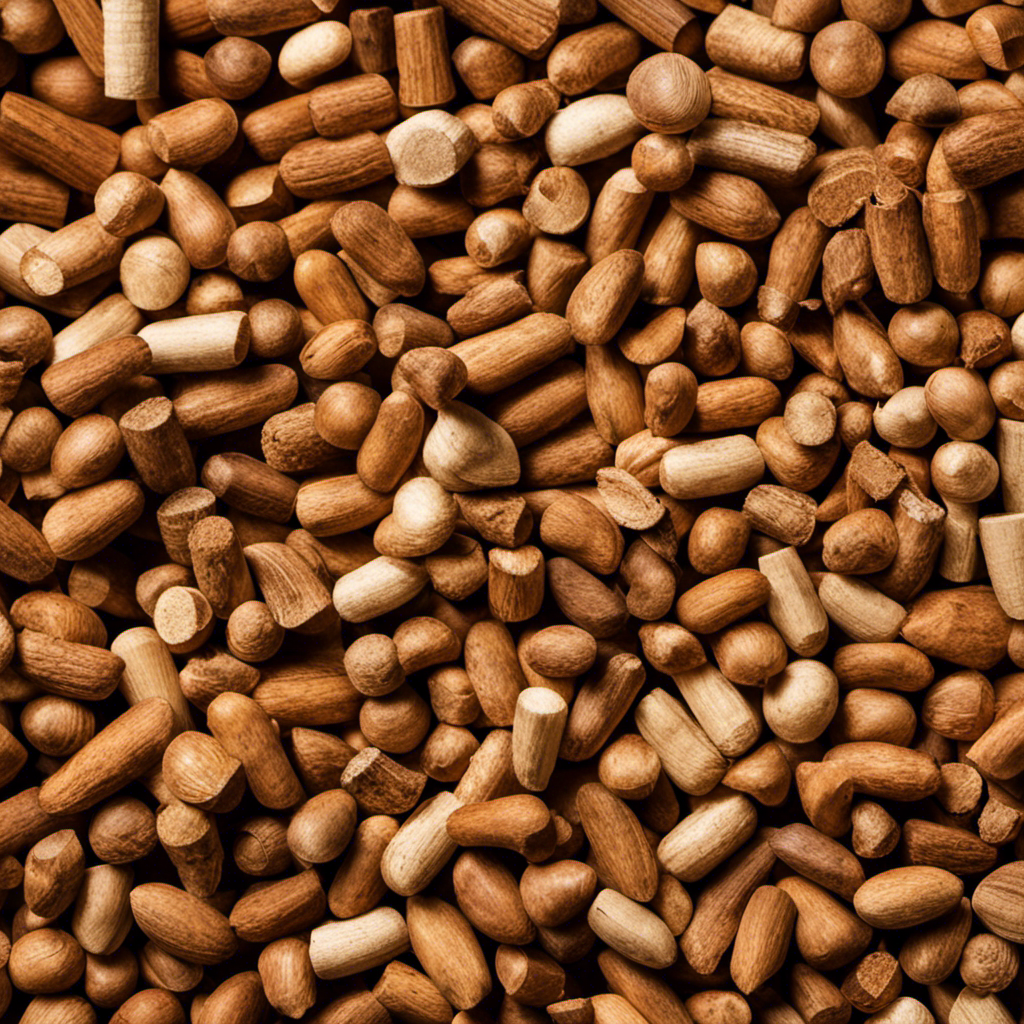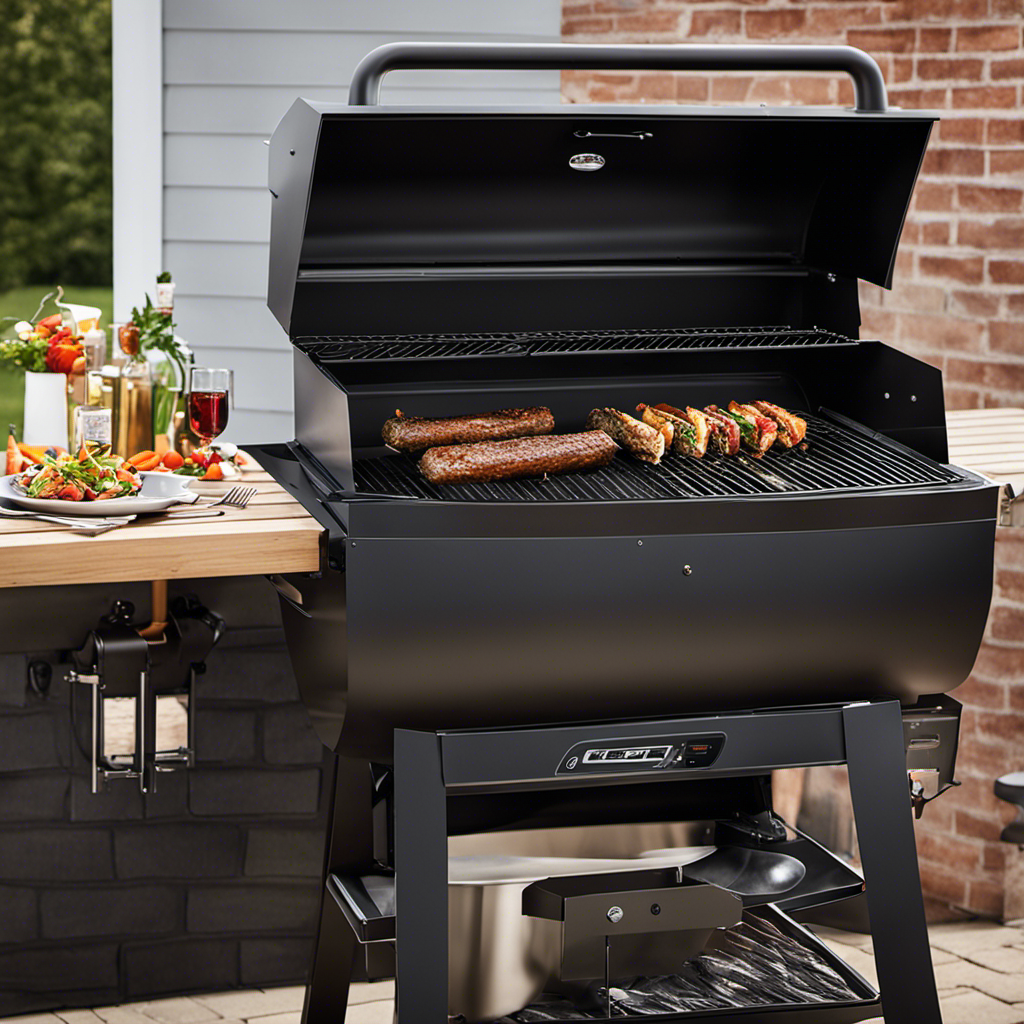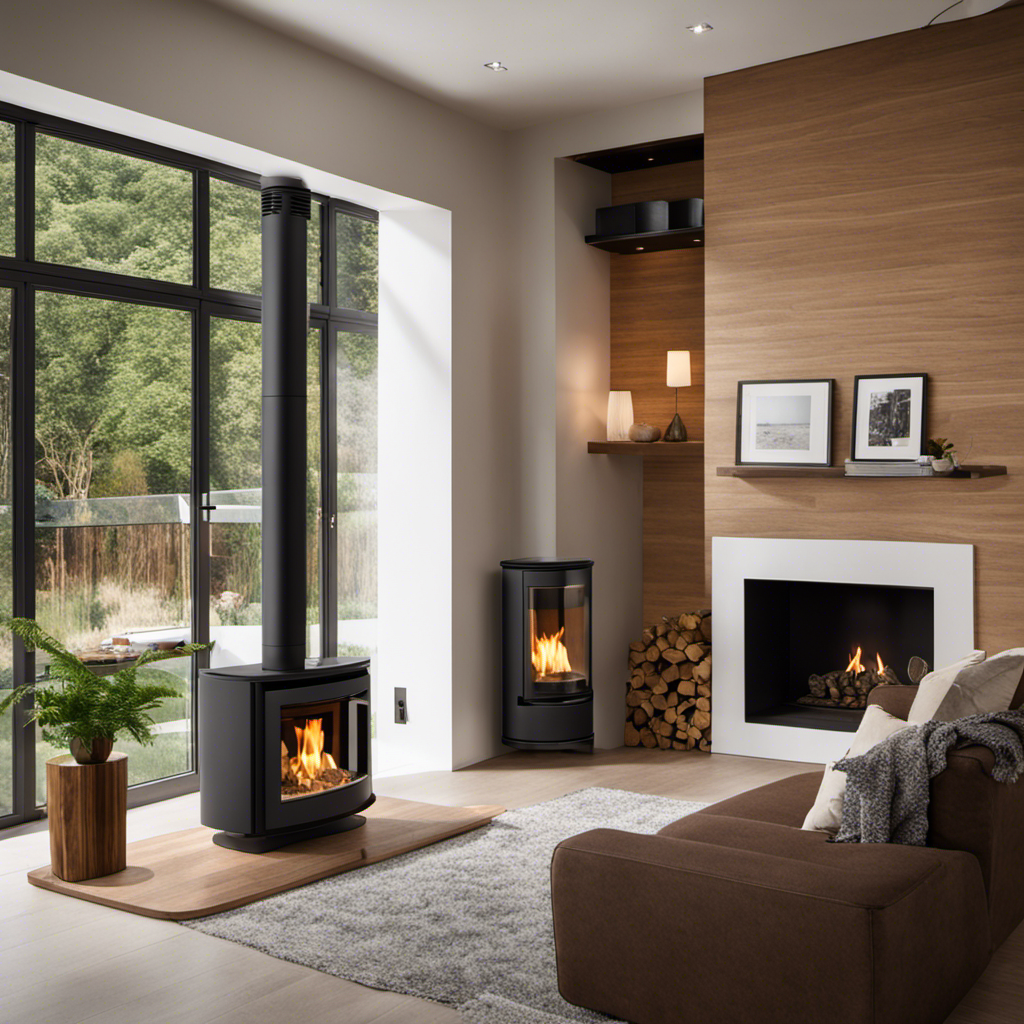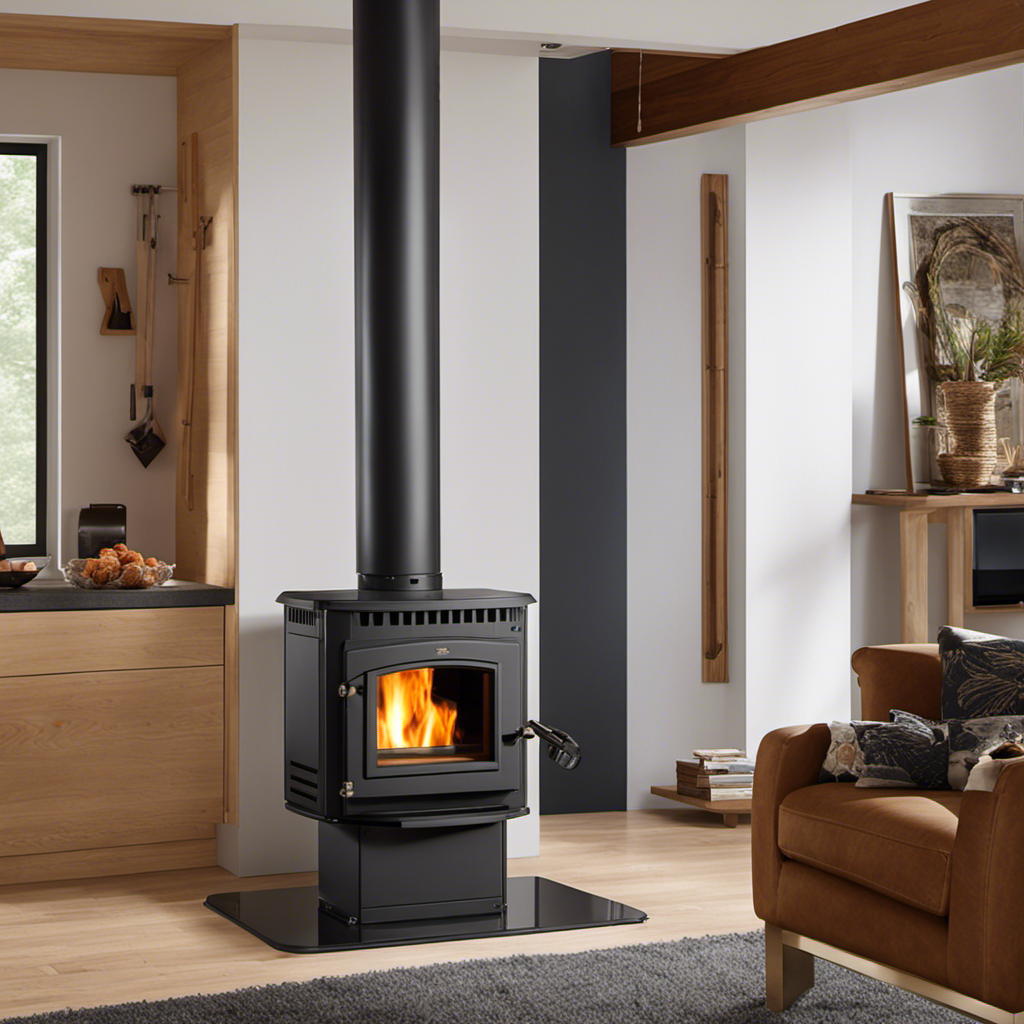I have some excellent advice for selecting the ideal wood pellet, whether it’s for heating your home or for barbecue grilling in your backyard. Making the right wood pellet selection can significantly improve your experience.
In this article, we’ll delve into the different types of wood pellets, factors to consider when choosing, evaluating quality, understanding certifications, comparing prices, and even highlight the best brands in the market.
Plus, I’ll share some handy tips on storing wood pellets and the environmental benefits of using them.
Let’s get started!
Key Takeaways
- Consider the type of wood used in the pellets (hardwood, softwood, or blended) for desired burn time and flame quality.
- Evaluate the quality of the wood pellet brand, such as Traeger, Bear Mountain, or CookinPellets.
- Pay attention to factors like moisture content and ash content when choosing wood pellets.
- Look for reliable certifications like ENplus, Pellet Fuels Institute, and Sustainable Forestry Initiative to ensure strict quality and sustainability standards.
Types of Wood Pellet
There’s a variety of wood pellet types available for you to choose from. When it comes to types of wood pellet, there are a few key options to consider.
First, there are hardwood pellets, which are made from dense woods like oak or hickory. These pellets provide a longer burn time and produce a higher heat output.
On the other hand, softwood pellets, such as those made from pine or spruce, ignite quickly and create a vibrant flame. They are perfect for those who want a quick and efficient heat source.
Additionally, there are also blended pellets, which combine different types of wood for a unique burn experience.
Some of the best wood pellet brands include Traeger, Bear Mountain, and CookinPellets.
Now that you’re familiar with the types of wood pellet available, let’s move on to the factors to consider when choosing wood pellet.
Factors to Consider When Choosing Wood Pellet
When considering factors for selecting the right wood pellet, you’ll want to take into account the quality, moisture content, and ash content. Evaluating wood pellet efficiency is essential to ensure optimal heating performance and cost-effectiveness.
Here are three key benefits of using wood pellet heating:
-
Energy efficiency: Wood pellets have a high energy density, meaning they produce more heat per unit compared to traditional firewood. This results in better fuel efficiency and lower heating costs.
-
Environmental friendliness: Wood pellets are made from compressed sawdust and other wood waste, making them a renewable and sustainable source of energy. They emit fewer greenhouse gases and have a lower carbon footprint compared to fossil fuels.
-
Consistent heat output: Wood pellets are manufactured to have a consistent size and moisture content, ensuring a reliable and steady heat output. This allows for better temperature control and heating efficiency.
Considering these factors and benefits, it becomes evident that evaluating wood pellet quality is crucial in making an informed decision for your heating needs.
Evaluating Wood Pellet Quality
Evaluating the quality of wood pellets is essential for making an informed decision about your heating needs. When it comes to evaluating wood pellets, it is important to understand the wood pellet manufacturing process.
High-quality pellets are made from pure wood fibers, without any additives or fillers. The manufacturing process involves grinding the wood into fine particles, compressing them under high pressure, and then heating them to form pellets.
These pellets have several benefits when used for heating. They are a renewable energy source, produce minimal ash and emissions, and offer consistent heat output.
Understanding the wood pellet manufacturing process can help you determine the quality of the pellets you are considering. This knowledge will be useful as we delve into understanding wood pellet certifications, which provide further assurance of quality.
Understanding Wood Pellet Certifications
When it comes to wood pellet certifications, it’s important to understand which certifications are reliable and trustworthy.
Reliable certifications, such as those from organizations like the Pellet Fuels Institute (PFI) and the Sustainable Biomass Program (SBP), ensure that wood pellets meet strict quality and sustainability standards.
However, it’s also crucial to consider the environmental impact of certifications, as some may not adequately address issues like deforestation or carbon emissions.
Reliable Wood Pellet Certifications
There’s a variety of reliable wood pellet certifications to consider when looking for renewable energy sources and sustainable heating options.
One of the most recognized certifications is the ENplus certification, which ensures that the pellets meet strict quality standards and are produced sustainably.
Another reliable certification is the Pellet Fuels Institute (PFI) certification, which guarantees that the pellets meet specific standards for quality and performance.
Additionally, the Sustainable Forestry Initiative (SFI) certification ensures that the pellets come from responsibly managed forests.
These certifications not only provide assurance of the quality and sustainability of the pellets but also help consumers make informed choices.
Understanding the environmental impact of certifications is crucial when selecting wood pellets, as it allows us to support the most environmentally responsible practices in the industry.
Environmental Impact of Certifications
One of the key factors to consider when assessing the environmental impact of certifications is the source of the pellets. Here are four reasons why this is important:
-
Carbon footprint: Wood pellets derived from sustainably managed forests have a significantly lower carbon footprint compared to those sourced from clear-cutting or deforestation practices. By choosing certifications that prioritize sustainable sourcing, you can help reduce greenhouse gas emissions and combat climate change.
-
Renewable energy sources: Certifications that prioritize renewable energy sources for pellet production ensure that the pellets are made from materials like sawdust or wood waste, rather than cutting down live trees. This helps to preserve natural habitats and biodiversity.
-
Ecological impact: Certifications that have strict guidelines for forest management help protect ecosystems and wildlife. By ensuring that the pellets are sourced responsibly, you can contribute to the conservation of natural resources and habitats.
-
Long-term sustainability: Choosing certifications that prioritize sustainable sourcing of pellets helps to ensure the long-term availability of this renewable energy source. By supporting responsible practices, you are helping to create a more sustainable future.
Considering these factors, it is crucial to assess the source of the pellets when evaluating the environmental impact of certifications. This knowledge will guide you as we transition into the subsequent section about comparing wood pellet prices.
Comparing Wood Pellet Prices
When it comes to comparing wood pellet prices, there are several important factors to consider.
First, it’s crucial to strike a balance between cost and quality. While a lower price may be tempting, it’s important to ensure that the pellets meet the necessary standards and provide efficient heat output.
Additionally, it’s essential to evaluate the reliability of the supplier to ensure consistent availability and timely delivery.
Lastly, environmental sustainability should be taken into account to make an eco-friendly choice that minimizes carbon emissions and promotes responsible sourcing and production practices.
Cost Vs. Quality
To determine the best wood pellet for you, consider the balance between cost and quality. Conducting a cost analysis is crucial in finding a pellet that fits your budget without compromising on performance. Start by reading product reviews to get an idea of the quality and effectiveness of different brands. Then, compare the prices of these pellets to see which ones offer the best value for money.
Remember, higher-priced pellets may have better quality and burn longer, but they may not always be necessary depending on your needs. Take into account factors such as the BTU rating and ash content to make an informed decision.
Now, let’s move on to the next aspect of choosing wood pellets – supplier reliability.
Supplier Reliability
Finding a reliable supplier is essential when considering the quality and cost of wood pellets. Supplier reputation and customer reviews play a crucial role in making an informed decision.
A reputable supplier is one that has a track record of delivering high-quality wood pellets consistently. Checking customer reviews can provide insights into the supplier’s reliability, timeliness, and customer service. It is important to look for positive feedback regarding the supplier’s product quality and delivery process.
By choosing a reliable supplier, you can ensure that you receive wood pellets that meet your standards and expectations.
Now, let’s transition into the next section about environmental sustainability.
Environmental Sustainability
By using sustainable practices, suppliers can ensure that their products have a minimal impact on the environment. One important aspect of environmental sustainability is reducing carbon footprint. This can be achieved by employing renewable energy sources in the production of wood pellets.
Renewable energy sources such as solar or wind power can significantly decrease the carbon emissions associated with the manufacturing process. Additionally, suppliers should consider the sourcing of their raw materials. Opting for sustainably managed forests and using wood waste from other industries can further reduce the environmental impact.
It is crucial for consumers to choose wood pellet brands that prioritize these sustainable practices. Now, let’s delve into the discussion of the best wood pellet brands in the market, ensuring that you make an informed decision when purchasing wood pellets.
Best Wood Pellet Brands in the Market
When it comes to choosing the best wood pellet brands in the market, there are a few important factors to consider: quality, price, and customer reviews.
Firstly, it’s important to look for brands that have a wide distribution network and are readily available in your area. This ensures that you won’t have trouble finding pellets when you need them.
Secondly, check for certifications like the Pellet Fuels Institute (PFI) seal, which guarantees that the pellets meet industry standards. Quality pellets will burn efficiently, produce less ash, and provide consistent heat.
Lastly, take the time to read customer reviews and ratings of different brands. This will give you insights into the experiences of others and help you make an informed decision.
Considering these factors will ensure that you choose the best wood pellet brand for your needs. Now, let’s move on to some tips for storing wood pellets without compromising their quality.
Tips for Storing Wood Pellet
To ensure your stored wood pellets maintain their quality, you should keep them in a dry and clean area. Proper wood pellet storage is crucial for preserving the fuel’s effectiveness and preventing any degradation. Moisture control is a key factor in maintaining the quality of wood pellets. Excessive moisture can lead to clumping, mold growth, and decreased heating efficiency.
It is recommended to store wood pellets in a sealed container or bag to protect them from moisture. Additionally, storing pellets off the ground can prevent moisture absorption from the floor. Regularly inspecting the storage area for any signs of moisture or damage is essential. By following these wood pellet storage tips, you can ensure that your fuel remains in optimal condition for efficient heating.
Moving on to the environmental benefits of wood pellet heating…
Environmental Benefits of Wood Pellet Heating
Wood pellet heating offers a more sustainable and eco-friendly alternative to traditional fuel sources. By using wood pellets as a renewable energy source, we can significantly reduce our carbon footprint and contribute to a cleaner environment. Here are some key environmental benefits of wood pellet heating:
-
Wood pellet production: Wood pellets are made from compacted sawdust and wood waste, which are byproducts of the timber industry. By using these materials, we are effectively recycling and reusing wood waste, reducing the need for traditional fuel sources like coal or oil.
-
Renewable energy: Wood pellets are considered a renewable energy source because they are made from sustainably managed forests. Unlike fossil fuels, which are finite resources, wood pellets can be continuously produced as long as there is a responsible approach to harvesting and replanting trees.
-
Reduced greenhouse gas emissions: When wood pellets are burned, they release carbon dioxide (CO2), but this is offset by the fact that the trees used to produce the pellets absorb CO2 during their growth. This creates a carbon-neutral cycle, where the emissions from burning wood pellets are balanced by the CO2 absorbed by new tree growth.
Frequently Asked Questions
Can Wood Pellets Be Used in Any Type of Heating System?
Wood pellets can be used in various types of heating systems, including furnaces and boilers. They offer several advantages, such as high energy efficiency, low emissions, and cost-effectiveness, making them a popular choice for heating homes and commercial buildings.
How Long Do Wood Pellets Typically Last?
Wood pellets typically last anywhere from 1 to 3 years, depending on factors such as wood pellet storage conditions, moisture content, and quality. It’s important to keep them in a dry, well-ventilated area for optimal lifespan.
Are Wood Pellets Safe to Use Indoors?
Yes, wood pellets are generally safe to use indoors. However, it’s important to consider their impact on indoor air quality. Poorly made pellets or those with high moisture content can release harmful pollutants, leading to potential health risks.
Can Wood Pellets Be Used for Cooking or Grilling?
Wood pellets for smoking are a great choice for cooking or grilling. They provide a smoky flavor and consistent heat. The advantages of using wood pellets include easy temperature control, clean burning, and a natural, authentic taste.
Are There Any Special Maintenance Requirements for Wood Pellet Heating Systems?
Special maintenance requirements for wood pellet heating systems include regular cleaning of the stove or boiler and inspection of the chimney. However, the benefits of these systems, like efficiency and cost savings, make it worth the effort.
What Should I Look for in Wood Pellet Specifications When Choosing Wood Pellets?
When choosing wood pellets, look for the best wood pellet spec. Check for low ash content, high heat output, and uniform pellet size. Look for pellets made from hardwood or a blend of hardwood and softwood. Consider the moisture content and the percentage of fines. Choose pellets that meet the highest industry standards.
Conclusion
After extensively researching and evaluating various factors, I have come to the conclusion that choosing the perfect wood pellet is a breeze.
With the abundance of options available and the overwhelming amount of information to consider, it’s truly a joyride. Who wouldn’t want to spend hours comparing prices, studying certifications, and analyzing wood pellet quality?
And don’t even get me started on the environmental benefits of wood pellet heating. It’s simply mind-blowing!
So, embrace the excitement, my friends, and embark on your wood pellet journey with a smirk of irony on your face. Happy pellet hunting!
Growing up surrounded by the vast beauty of nature, Sierra was always drawn to the call of the wild. While others sought the comfort of the familiar, she ventured out, embracing the unpredictable and finding stories in the heartbeat of nature.
At the epicenter of every remarkable venture lies a dynamic team—a fusion of diverse talents, visions, and passions. The essence of Best Small Wood Stoves is crafted and refined by such a trio: Sierra, Logan, and Terra. Their collective expertise has transformed the platform into a leading authority on small wood stoves, radiating warmth and knowledge in equal measure.











